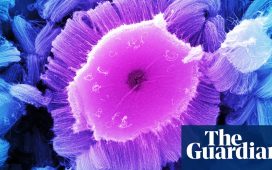Several billion years ago, at the dawn of the solar system, a wet, salty world circled our sun. Then it collided, catastrophically, with another object and shattered into pieces.
One of these lumps became the asteroid Bennu whose minerals, recently returned to Earth by the US robot space probe OSIRIS-REx, have now been found to contain rich levels of complex chemicals that are critical for the existence of life.
“There were things in the Bennu samples that completely blew us away,” said Prof Sara Russell, cosmic mineralogist at the Natural History Museum in London, and a lead author of a major study in Nature of the Bennu minerals. “The diversity of the molecules and minerals preserved are unlike any extraterrestrial samples studied before.”
Results from this and other missions will form a central display at a Natural History Museum’s exhibition, Space: Could Life Exist Beyond Earth?, which opens on 16 May. It will be a key chance for the public to learn about recent developments in the hunt for life on other worlds, said Russell.
As the exhibition will reveal, the basic chemical building blocks for life can be found in other objects in the solar system such as meteorites. However, the material from Bennu, which is named after an ancient Egyptian mythological bird, have been found to be particularly rich in these deposits. “Its parent world clearly had underground lakes of brine, and when these evaporated they left behind salts that resemble those found in dry lake beds on Earth,” said Russell.
In addition, phosphates, ammonia and more than a dozen protein-building amino acids that are present in life forms on Earth – as well as the five nucleobase building blocks that make up RNA and DNA – were found in the samples brought back by OSIRIS-REx.
“These strongly suggest that asteroids similar to Bennu crashed on to Earth, bringing crucial ingredients that led to the appearance of life here,” she added.
Scientists do not believe life evolved on Bennu itself but do think other asteroids like it might have supplied other worlds with the basic ingredients for life. On Earth, with its warm, stable environment, this led to the first appearance of reproducing organisms more than 3.7 billion years ago. It remains to be seen if they appeared on other promising worlds such as Mars and the moons of Jupiter and Saturn, that include Europa, Ganymede, Titan and Enceladus. These are now the subject of a number of missions that will feature in the exhibition and include two probes now heading for Jupiter’s ice-covered moons Europa and Ganymede, which are known to possess liquid water oceans.
In addition, the UK-built Rosalind Franklin robot rover is scheduled to land on Mars in 2029 and will drill deep into its soil, seeking evidence of life.
In the past, samples of extraterrestrial rocks made available for study have been limited mainly to meteorites, pieces of the moon brought back by astronauts and robot probes, and lumps of Mars that were blasted towards Earth when large objects struck the red planet and blew debris into space – with some eventually falling on to our world as Martian meteorites.
Visitors to the exhibition will be able to touch samples of lunar and Martian material as well as a meteorite that landed on our planet after breaking off from an asteroid. Intriguingly, this rock is older than the Earth itself.
“This is going to be a blockbuster,” said Sinead Marron, the museum’s senior exhibitions manager.
OSIRIS-REx brought back 120gm of Bennu dust to Earth, and the museum has been given around 200mg to study, said Russell. “When we first opened the capsule, we saw this black dust everywhere, with white particles in it. We thought it might be contaminated. But it turned out to be a compound of phosphorus we have not seen in meteorites but which is absolutely crucial to the development of life. I was astonished.”
The prospects that life might exist elsewhere in the universe made headlines last week when it was announced that observations of the exoplanet K2-18b by the James Webb space telescope had revealed the chemical fingerprints of two compounds that, on Earth, are only known to be produced by life.
On their own, the chemicals, dimethyl sulfide (DMS) and dimethyl disulfide (DMDS), do not amount to proof of alien biological activity but they have boosted hopes that we are not alone in the universe.
Conclusively proving that life exists on distant worlds outside our solar system will be extremely hard, scientists acknowledge – short of a signal from an extraterrestrial intelligence announcing its existence.
By contrast, alien lifeforms within our solar system will be easier to collect and study and may prove, one day, that life on other worlds does indeed exist.
“What we would do about such a discovery is a different matter,” Marron said. “One of the things we will be asking exhibition visitors to think about is how we would treat life if we found it on Mars or another world. Would we stay away from it or try to interact with it?
“Or would we try to eat it, like we eat lifeforms with whom we share this planet? Such questions about alien life help us reflect on the ways we engage with other forms of life in our own world.”









